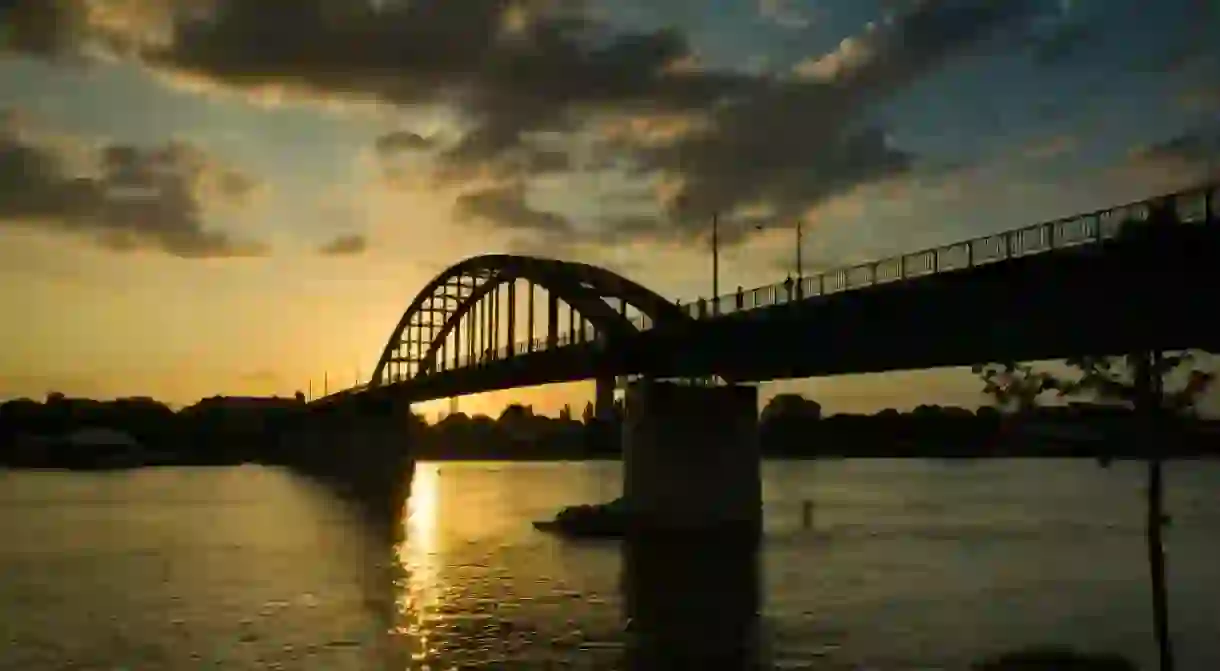8 Delightful Bridges in Serbia

Serbia might not possess the magnificent roster of stone bridges found in Bosnia & Herzegovina, but what it lacks in Ottoman architecture it makes up in modernist arches and more. These are the finest bridges in Serbia, including one that isn’t actually near any water at all.
Dry Bridge
Not all bridges provide a way over a physical obstacle, although that really is the primary purpose of them. Charming Zrenjanin, located in Serbia’s northern province of Vojvodina, is home to one of the most curious pieces of construction in the country. The Dry Bridge was built in 1962, but two decades later the Begej river was rerouted and the bridge was left redundant. It still stands as a lonely image of superfluousness, but it has resisted all attempts to knock it down.

Bridge of Love
Vrnjačka Banja might not be able to match New York, Paris or Barcelona in the modern romance stakes, but it was in this small western Serbian town that the love lock craze began. Over a century has passed since a young couple from the town solidified their union via padlock and ink, just in time for the poor boy to go off to a war he wouldn’t return from. The bridge is still there today, although you might not be able to see it with all the locks.

Ada Bridge
One of the biggest and most expensive construction projects in Serbia’s proud history, the Ada Bridge is a rare example of money well spent in this part of the world. This is the world’s largest single pylon suspension bridge and it sure does look like it. The bridge was actually planned as far back as 1923, but it is most definitely a 21st century piece of engineering.

Žeželj Bridge
It took almost two decades, but the iconic arches connecting Bačka and Srem have risen again. The Žeželj Bridge in Novi Sad was destroyed during the NATO aggression in 1999, along with the other bridges in the city that spanned the Danube. The work of prominent Yugoslav engineer Branko Žeželj, the original design was mimicked as closely as possible without ignoring the need for a modern touch. Serbia is a country that has had to do plenty of rebuilding, and the new Žeželj Bridge is further proof.

White Bridge
Vrnjačka Banja isn’t the only place that has its own Bridge of Love, as the southeastern city of Vranje also has its own romantic overpass. It is better known as the White Bridge, which should clue you in as to the colour and hue of this delightful 19th century Ottoman construction. The bridge was built in memory of yet another Romeo & Juliet type story in the Balkans, this time concerning a Muslim girl who fell in love with a Serb. Her father tried to murder the boy, but accidentally ended the life of his own daughter as she protected her beau. Rough times, to say the least.
Nine Throats Bridge
Don’t be put off by the slightly intimidating name, as there is a very clear reason for it. The Devet grla (Nine Throats) bridge is found near Mokrin, a town nestled in the very northern tip of the country on the border with Romania. The name comes from the nine arches that the bridge possesses, as opposed to anything more sinister, and is one of the rare gorgeous bridges in the region that was built with Habsburg money.

Branko’s Bridge
It isn’t exactly the most picturesque of bridges, but it is difficult to imagine a functioning Belgrade without the part played by Brankov Most. The bridge connects Belgrade’s centre to New Belgrade and Zemun, and is also a good place to head to get a view of Belgrade from high above the river. The bridge is named after Serbian romantic poet Branko Radičević, but an informal name comes from the tragic story of Branko Ćopić, who committed suicide by jumping from the bridge in 1984.
Old Sava Bridge
The smallest road bridge in Belgrade, the Old Sava Bridge actually opened during the German Occupation of Serbia. Even more remarkably, it was the only major European bridge that the Germans didn’t destroy as they withdrew from their various positions. That isn’t to say they didn’t try, but the Old Sava Bridge was remarkably saved by a man by the name of Miladin Zarić, who risked his life to defuse the bombs attached to this famous crossing. Strangely enough, it doesn’t have an official name.














